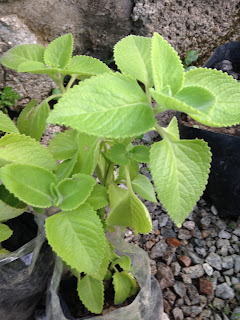I feel blessed that I have my farm as I can grow and produce all kinds of tasty, fresh produce organically and know that it has not been contaminated by toxic chemicals. I love eating well and I hate eating pills or supplements so I try to balance what I ear. After my previous experience of having to undergo hormone treatment, I have an aversion to anything that has been given hormones and this includes meat, vegetables and fruits. Some may argue that hormone doesn't disqualify the produce from being classified as organic because it is not a toxic chemical but for me, I avoid it.
So, what do I consume from the farm ( these are some, there are lots more):
 Fresh coconut drink
Fresh coconut drink
This drink is great for many things and tastes especially wonderful on hot days, especially these last many days with the El Nino phenomenon as well as Equinox. It doesn't require any refrigeration and tastes cool straight from the fruit. It is a natural cleanser so whilst I am enjoying the drink, I am detoxing. A good fruit produces sweet coconut water so there is no need to sweeten it. The coconut water is a natural isotonic so you can give a pass to all those man-made isotonic drink to replace the electrolytes you lose as you perspire - natural electrolytes: how much better can you ask for? So, with the current heat wave in Malaysia, this is a great way to rehydrate.
Fresh tumeric and Bentong Ginger Tea
I enjoy this drink as one of my end-of-day chill out drinks. I drink it warm, often as an after dinner drink. The benefits are numerous but what I of for here is for the "repairing" capabilities so that while I am sleeping and my body tries to repair itself from the numerous damage I do to it during the day, this tea boosts up my body's repair works. Since what is used is the "roots" part of it, to me, it is important that the soil is not contaminated or else I will be getting some "unwanted" items in my tea. It is easy to do - just bring water to boil and add slices of fresh numeric and bettong ginger and allow it to simmer for at least 10 minutes to draw out the good stuff from the roots into the water. Sometimes I sweeten it but I avoid using refined sugar.
SHL Salad
At least this is what I call it. It comprises of various types of fresh leave and flowers such as holy basil, lemon basil,
Ketumpang Cina, Ulam Raja,
Tujuh Bilah, Tenggek Burung, Cabbage - to name a

few. I mix it up and use different combinations. They all provide all kinds of benefits so I will tailor my salad mix depending on what I want to get out of it from a therapeutic benefit. Sometimes I go for strengthening my respiratory system or when I have a cold, sometimes for an anti-oxidant boost , sometimes for vitamins and sometimes for cleansing. I do not like eating supplements although some may argue that by taking supplements is the only way you can get enough vitamins daily easily, I prefer to do it through my meals and "desserts".
Natural desserts

We have several types of fruits, some seasonal and some that is throughout the year. Top on my list is the papaya - full of wonderful enzymes and rich in vitamins as well as fiber. To me, this beats Metamucil hands down. Not only can you eat it as an after-meal dessert, it is also a great breakfast item. Sometimes I will go for bananas and since we have over 20 varieties of it at the farm, I can enjoy different types of bananas throughout the year. The bananas can be eaten raw or turned into another dish such as grilled bananas, banana fritters, as well as different types of banana desserts with a sauce. For seasonal fruits, there is the jackfruit,
cempedak, mangosteens, abiu, durian,
jambu madu, longan, rambutan and breadfruit. I am hoping my passion fruit will produce fruits in less than 1 year. The two things I can be sure of is that they are grown organically and free from hormone treatment.
Farm fresh anti-biotic free, hormone free free range chicken eggs
These eggs are simply beautiful and delicious. The yolk is golden yellow - almost orange and the size of the egg is small but it packs lots of goodness. One thing I find is that it doesn't have that smell that is so common in the commercial eggs - the Malays say "
hanger". Eggs used to get a bad name but I think it has more to do with the way the eggs are produce and the feed given to the hens as well as all those "medications".
 Herbal teas
Herbal teas
I make different types of teas and they all have therapeutic value. My teas are mainly for prevention and maintenance purposes and so far, Alhamdulillah, it seems to be good for me. Some of the teas that I consume are
Misai Kuching, Soursop Leaves, Soursop with Lemon Grass, Lemon Basil, Holy Basil, and Indian Borage. When I am at the farm, I tend to make them with fresh leaves but I do some in dried form so that I can take it with me anywhere or to have it at home whenever I want.
Summary
I guess being someone who hates taking supplements and popping pills as well as having to think whether it should be taken 30 minutes before a meal, before a meal, after a meal, on empty stomach - there are so many "rules", how I eat makes a difference and I get to enjoy it.


















